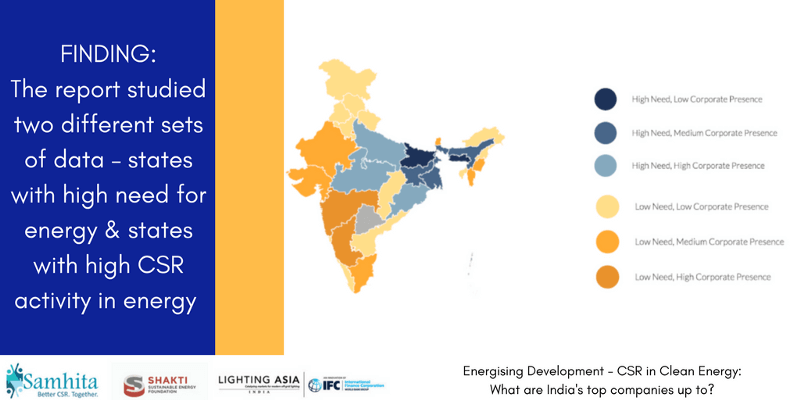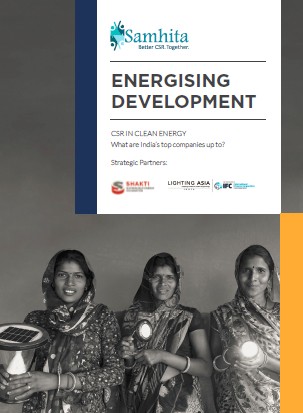India requires companies to spend 2% of profit on CSR. New research shows just a tiny fraction of that spend going to clean energy, with money often failing to reach the most energy-poor regions
A new report issued by Samhita Social Ventures for the first time analyzes the corporate social responsibility (CSR) spend by India’s top publicly-traded companies on bringing electricity to India’s 300 million rural population living without energy access. The report said the total budget for CSR on clean energy projects in Fiscal Year 2015–16 among leading companies was approximately INR 1.83 billion ($29 million), which accounted for just 6% of their total CSR spend.
According to the report, of the top 100 companies (based on CSR spend) listed on India’s BSE 500 stock exchange, only 39% invested in clean energy. By comparison, almost 90% of the companies have a CSR program in education, sanitation or skills and livelihoods. The lower engagement in energy was due to a perception that energy access interventions are more technical combined with a desire to see direct outcomes, the report said.
When investing in clean energy, most companies preferred to take a product-based approach, with a preference for solar energy, the report said. In addition, investment is often in regions close to corporate headquarters, which frequently doesn’t match where financial support is most needed. For example, the need for intervention is highest in Bihar and Meghalaya states, but CSR participation there remains inadequate. Similarly, Karnataka and Maharashtra, which face relatively low energy gaps, have a high proportion of company energy access programs.

“The market potential and expanse of the Clean Energy Sector has been discussed and emphasized by many. However, CSR participation still remains low and sparse,” Samhita CEO Priya Naik said. “Furthermore, the structuring of CSR programs in this sector often lacks a holistic and catalytic approach which then impedes the delivery and scope of these programs and hinders impact.”
In June 2014, the Ministry of Corporate Affairs said that renewable energy projects would be included as CSR initiatives. The 2% CSR rule applies to companies having at least 50 million rupee net profit, 10 billion rupee turnover or 5 billion rupee net worth.
Gram Oorja, a Pune-based for-profit social enterprise, has been one of the most active Indian mini-grid developers to make use of CSR investment, working with Bank of America, Bosch, Panasonic, Tata and others on a number of projects in multiple states. Their model is to use the CSR money as a one-time investment to get the mini-grid up and running, then operating on a commercial basis. Village electrification committees collect tariffs that are used for ongoing operation and maintenance.

“Energy access is not even in the top 10 issues that corporations focus on,” Sameer Nair, director at Gram Oorja, told Power for All. “We had to convince them that energy access is an integral part of anything they want to do that’s related to improving health, livelihood or education.”
But, Nair added, it is still less challenging to convince corporations than governments to fund rural community energy projects.
Traditional CSR is not the ultimate solution for addressing electricity access, according to a World Economic Forum report, noting that “most projects from multinational companies (other than projects from social entrepreneurs) are designed purely from a CSR or philanthropic perspective. In many cases this non-market based approach leads to limited scope and lack of any long-term impact as there is no strategic investment involved.”
However, with India’s total CSR spend hitting 83 billion rupee ($1.3 billion) in 2015–16 and access to finance still a major issue for last-mile clean energy providers in India, an increase in the number of companies investing in clean energy could make a significant difference, especially if they take a longer-term, programmatic approach.
